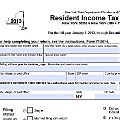- By Kate Gurnett
- News
 Print
Print  New York State Comptroller Thomas P. DiNapoli announced today his office stopped more than $24 million in questionable personal income tax refunds so far in 2014, after finding 7,482 improper filings – an 18 percent rise from last year. To date, DiNapoli's office audited and approved 4.8 million state refund requests totaling $4.3 billion. Another 346,000 refund requests totaling $352.5 million are expected to be paid in the coming days.
New York State Comptroller Thomas P. DiNapoli announced today his office stopped more than $24 million in questionable personal income tax refunds so far in 2014, after finding 7,482 improper filings – an 18 percent rise from last year. To date, DiNapoli's office audited and approved 4.8 million state refund requests totaling $4.3 billion. Another 346,000 refund requests totaling $352.5 million are expected to be paid in the coming days.“Those who break the rules will not profit at others’ expense,” DiNapoli said. “Tax cheats are continually coming up with new schemes to get money they aren’t entitled to. My office works diligently to make sure only legitimate refunds are paid.”
DiNapoli’s office audits all New York state bills prior to payment, including personal income tax refunds. The majority of questionable returns were filed by taxpayers who claimed refundable credits based on incorrect information such as fake or inflated number of dependents or understated income.
Questionable personal income tax refunds stopped to date include:
| Reason for Stopping Tax Refund | Number of Refunds | Dollar Value of Refunds |
| Taxpayer claimed ineligible refundable credits (e.g., fake or inflated number of dependents or understated income) | 4,805 | $16,043,950 |
| Tax preparer submitted returns with refundable credits based on incorrect information | 1,204 | 3,722,310 |
| Taxpayer had questionable social security number | 625 | 1,709,045 |
| Taxpayer failed to claim correct income | 467 | 1,216,845 |
| Taxpayer had questionable itemized deductions | 154 | 570,405 |
| Taxpayer claimed incorrect wages and withholding tax | 73 | 97,384 |
| Other | 154 | 724,326 |
| Total Refunds Stopped | 7,482 | $24,084,265 |
The Comptroller issued a separate report summarizing the results of his office’s audit of refunds during the period January 1, 2013 through December 31, 2013. During that year, DiNapoli’s auditors stopped 12,746 questionable refunds totaling over $93.3 million. Of the $93.3 million in questionable refunds, DiNapoli's auditors estimated their efforts produced $62.6 million in savings.
v10i14



